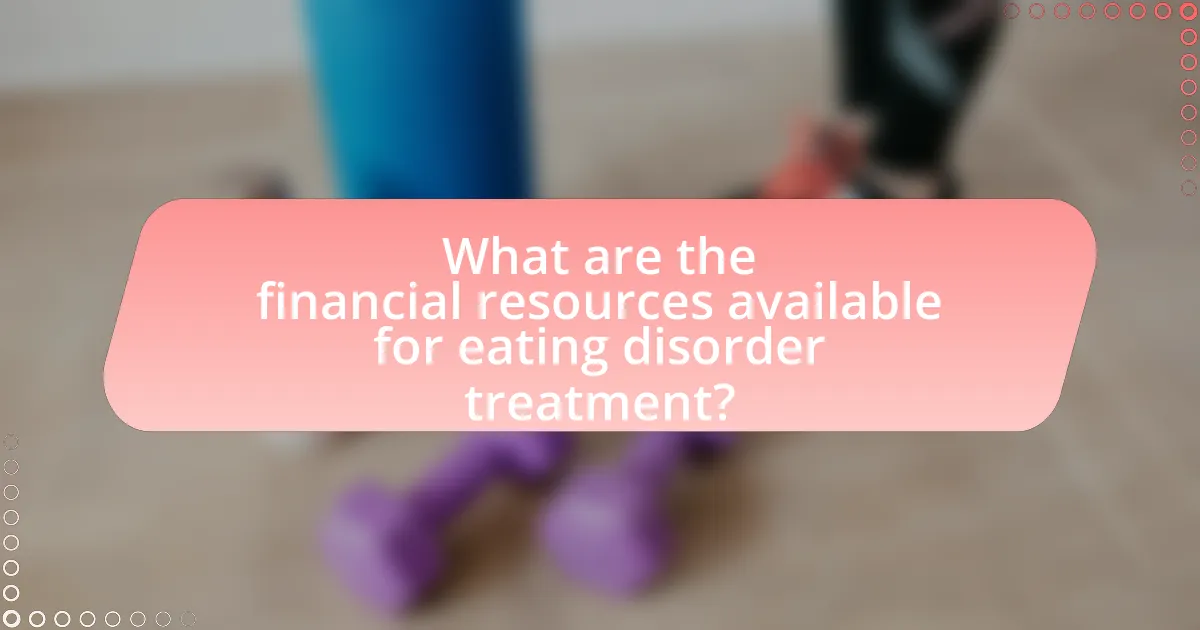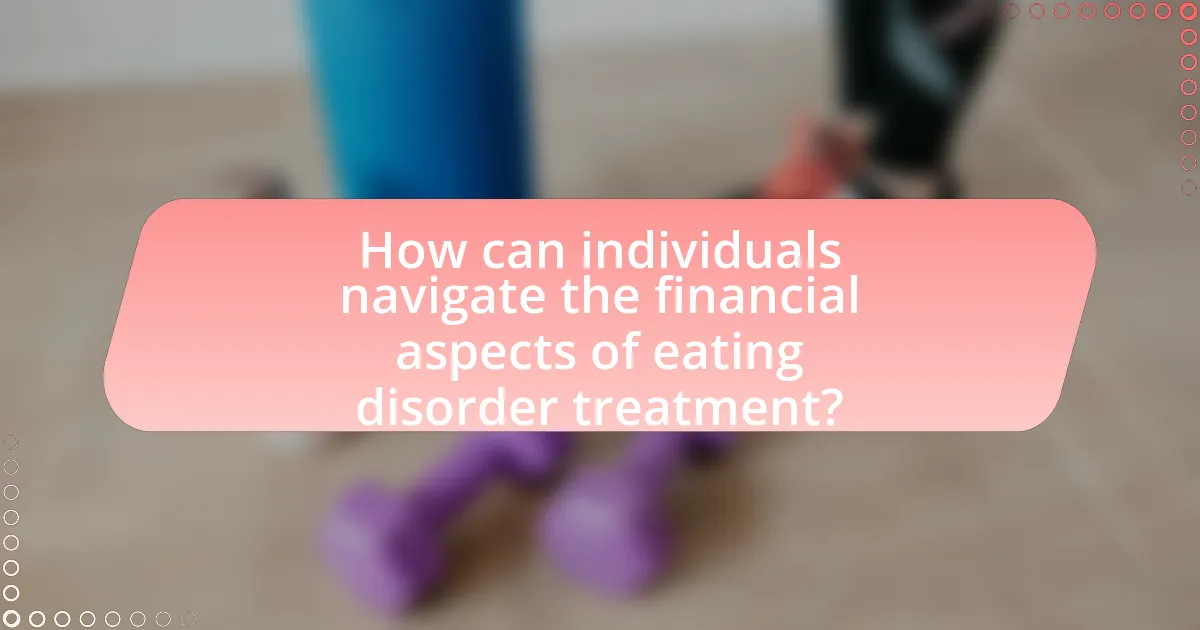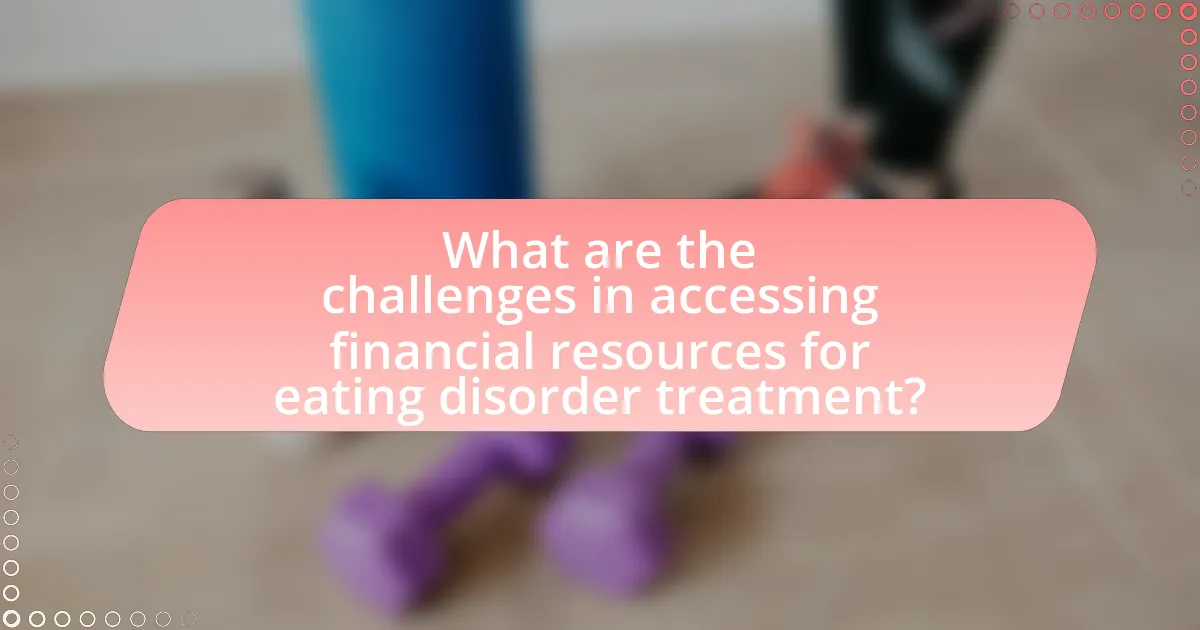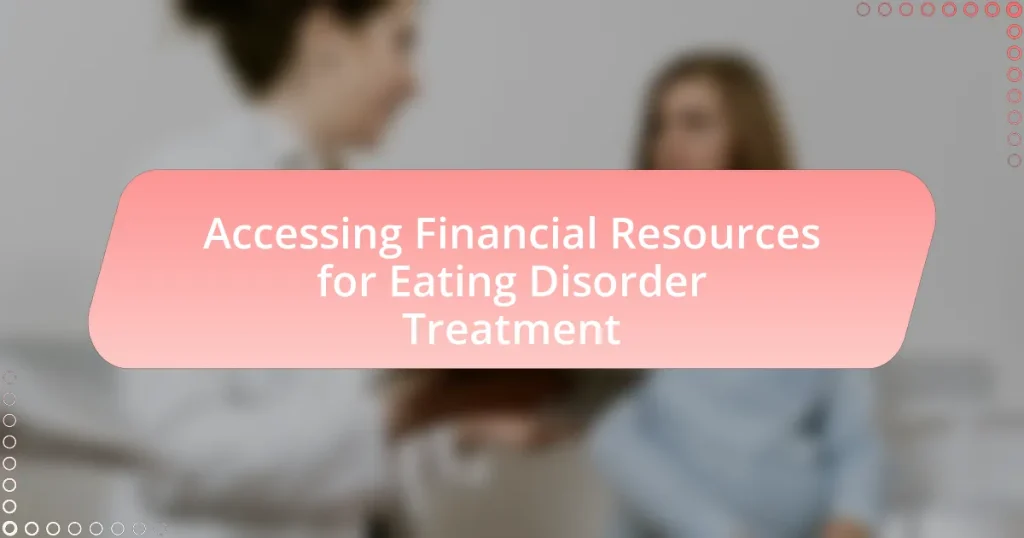Accessing financial resources for eating disorder treatment is crucial for individuals seeking help. This article outlines various financial options available, including health insurance coverage, government assistance programs like Medicaid and Medicare, and support from nonprofit organizations such as the National Eating Disorders Association. It details how individuals can identify their financial options, the types of insurance that cover treatment, and the role of government and nonprofit organizations in providing financial aid. Additionally, the article addresses challenges faced in accessing these resources, common misconceptions, and practical tips for navigating the financial aspects of treatment.

What are the financial resources available for eating disorder treatment?
Financial resources available for eating disorder treatment include health insurance coverage, government assistance programs, and nonprofit organizations that provide financial aid. Health insurance plans often cover a portion of the costs associated with inpatient and outpatient treatment for eating disorders, depending on the policy and state regulations. Government programs like Medicaid and Medicare can also provide financial support for eligible individuals seeking treatment. Additionally, organizations such as the National Eating Disorders Association offer grants and financial assistance programs to help those in need access necessary care.
How can individuals identify their financial options for treatment?
Individuals can identify their financial options for treatment by researching available resources such as insurance coverage, government assistance programs, and nonprofit organizations that offer financial aid. Insurance policies often provide coverage for mental health and eating disorder treatments, so reviewing the specific benefits and limitations of one’s plan is essential. Government programs like Medicaid may offer support for eligible individuals, while organizations such as the National Eating Disorders Association provide information on financial assistance options. Additionally, contacting treatment facilities directly can yield insights into payment plans and sliding scale fees based on income.
What types of insurance plans cover eating disorder treatment?
Insurance plans that cover eating disorder treatment typically include private health insurance plans, Medicaid, and Medicare. Private health insurance plans often provide coverage for inpatient and outpatient treatment, therapy, and nutritional counseling, depending on the policy specifics. Medicaid, which varies by state, generally covers medically necessary treatment for eating disorders, including hospitalization and therapy. Medicare also offers coverage for eating disorder treatment under certain conditions, particularly for older adults and individuals with disabilities. These coverage options are supported by the Mental Health Parity and Addiction Equity Act, which mandates that mental health services, including eating disorder treatment, be covered at the same level as physical health services.
How do government programs assist with treatment costs?
Government programs assist with treatment costs by providing financial support through various healthcare initiatives and insurance coverage options. For instance, Medicaid and Medicare offer coverage for mental health services, including treatment for eating disorders, which can significantly reduce out-of-pocket expenses for eligible individuals. According to the National Association of State Mental Health Program Directors, approximately 30% of individuals with eating disorders receive treatment through public insurance programs, highlighting the critical role these programs play in making treatment accessible.
What role do non-profit organizations play in funding treatment?
Non-profit organizations play a crucial role in funding treatment for eating disorders by providing financial assistance, grants, and resources to individuals and families in need. These organizations often raise funds through donations, fundraising events, and partnerships, which they allocate to support treatment programs, scholarships for therapy, and educational initiatives. For instance, the National Eating Disorders Association (NEDA) offers a financial assistance program that helps individuals access treatment services, demonstrating the tangible impact of non-profits in bridging the gap between patients and necessary care.
Which organizations provide financial assistance for eating disorders?
Organizations that provide financial assistance for eating disorders include the National Eating Disorders Association (NEDA), which offers a financial assistance program to help individuals access treatment. Additionally, the Eating Disorders Coalition for Research, Policy & Action advocates for funding and resources to support those affected by eating disorders. The Alliance for Eating Disorders Awareness also provides information on financial resources and treatment options. These organizations are recognized for their commitment to supporting individuals in need of financial help for eating disorder treatment.
How can individuals apply for grants or scholarships for treatment?
Individuals can apply for grants or scholarships for treatment by researching available funding options through organizations that specialize in eating disorders, such as the National Eating Disorders Association or local mental health foundations. These organizations often provide detailed application guidelines, eligibility criteria, and deadlines on their websites. Additionally, individuals should prepare necessary documentation, including proof of diagnosis, treatment plans, and financial need, to support their applications. Many grants and scholarships require applicants to demonstrate their commitment to recovery and may involve personal statements or letters of recommendation.

How can individuals navigate the financial aspects of eating disorder treatment?
Individuals can navigate the financial aspects of eating disorder treatment by exploring various funding options, including insurance coverage, sliding scale fees, and financial assistance programs. Many health insurance plans cover some aspects of eating disorder treatment, so individuals should verify their benefits and understand the extent of coverage. Additionally, treatment facilities often offer sliding scale fees based on income, making care more affordable. Non-profit organizations and support groups may also provide financial assistance or resources to help cover treatment costs. According to the National Eating Disorders Association, approximately 30 million Americans will experience an eating disorder in their lifetime, highlighting the importance of accessible treatment options.
What steps should be taken to assess treatment costs?
To assess treatment costs for eating disorder treatment, one should first gather detailed information on the specific treatment options available, including inpatient, outpatient, and therapy sessions. Next, it is essential to obtain cost estimates from various treatment providers, which can include hospitals, clinics, and private practitioners, as prices can vary significantly. Additionally, reviewing insurance coverage options is crucial, as many plans may cover a portion of the treatment costs, and understanding the specifics of the coverage can help in calculating out-of-pocket expenses. Finally, one should consider any additional costs associated with treatment, such as medication, transportation, and follow-up care, to arrive at a comprehensive assessment of the total financial commitment required for effective treatment.
How can individuals estimate the total cost of treatment?
Individuals can estimate the total cost of treatment by researching the specific treatment options available, including therapy sessions, medication, and any necessary hospital stays. They should gather information on the prices of these services from healthcare providers, insurance companies, and treatment facilities. For example, the average cost of outpatient therapy for eating disorders can range from $100 to $200 per session, while inpatient treatment can exceed $30,000 for a 30-day program. Additionally, individuals should consider their insurance coverage, as many plans may cover a portion of the treatment costs, which can significantly affect the total out-of-pocket expense. By compiling these details, individuals can create a more accurate estimate of their total treatment costs.
What factors influence the cost of eating disorder treatment?
The cost of eating disorder treatment is influenced by several key factors, including the type of treatment facility, the duration of treatment, the level of care required, and the geographic location of the facility. Treatment facilities can vary significantly in cost; for example, inpatient programs typically cost more than outpatient services due to the comprehensive care provided. The duration of treatment also affects overall expenses, as longer programs incur higher costs. Additionally, the level of care, such as whether a patient requires intensive therapy or medical supervision, directly impacts pricing. Geographic location plays a role as well, with urban centers often having higher treatment costs compared to rural areas. These factors collectively determine the financial burden of eating disorder treatment.
How can individuals negotiate with treatment providers regarding costs?
Individuals can negotiate with treatment providers regarding costs by directly discussing their financial situation and exploring available payment options. Initiating a conversation about affordability allows individuals to express their concerns and inquire about sliding scale fees, payment plans, or potential discounts. Research indicates that many healthcare providers are open to negotiation, especially when patients demonstrate a genuine need for financial assistance. For instance, a study published in the Journal of Health Economics found that transparent communication about financial constraints can lead to reduced costs for patients in various healthcare settings.
What strategies can be used to discuss financial concerns with providers?
To discuss financial concerns with providers, individuals should prepare a clear outline of their financial situation and specific questions. This preparation allows for a focused conversation that addresses concerns directly. Engaging in open dialogue about costs, payment plans, and available financial assistance programs is essential. Research indicates that patients who communicate their financial limitations are more likely to receive tailored support from providers, as many healthcare facilities have resources to assist with financial planning. Additionally, bringing documentation of income, insurance coverage, and any relevant expenses can help providers understand the individual’s financial context better, facilitating a more productive discussion.
How can payment plans be established for treatment services?
Payment plans for treatment services can be established by negotiating terms directly with the treatment provider or facility. Providers often assess the patient’s financial situation and may offer flexible payment options, such as monthly installments or sliding scale fees based on income. Research indicates that approximately 70% of treatment centers provide some form of financial assistance or payment plans to accommodate patients’ needs, thereby increasing access to necessary care.

What are the challenges in accessing financial resources for eating disorder treatment?
Accessing financial resources for eating disorder treatment presents several challenges, primarily due to high treatment costs, limited insurance coverage, and stigma associated with mental health issues. High treatment costs can deter individuals from seeking necessary care, as inpatient and outpatient programs often require significant financial investment. Limited insurance coverage exacerbates this issue, as many insurance plans do not fully cover specialized eating disorder treatments, leading to out-of-pocket expenses that can be prohibitive. Additionally, the stigma surrounding eating disorders may discourage individuals from pursuing treatment, further complicating access to financial resources. According to the National Eating Disorders Association, only 30% of individuals with eating disorders receive treatment, highlighting the barriers that exist in accessing necessary financial support for care.
What barriers do individuals face when seeking financial assistance?
Individuals face several barriers when seeking financial assistance for eating disorder treatment, including lack of awareness of available resources, complex application processes, and stigma associated with mental health issues. Many individuals are unaware of specific funding options or programs that could help cover treatment costs, which limits their ability to access necessary care. Additionally, the application processes for financial assistance can be complicated and time-consuming, deterring individuals from pursuing help. Stigma surrounding eating disorders and mental health can further discourage individuals from seeking assistance, as they may fear judgment or discrimination. These barriers collectively hinder access to essential financial support for treatment.
How does lack of insurance impact access to treatment?
Lack of insurance significantly restricts access to treatment for eating disorders. Individuals without insurance often face high out-of-pocket costs for therapy, medication, and hospitalization, leading to delayed or foregone care. According to a study published in the Journal of Eating Disorders, uninsured individuals are less likely to seek treatment, with only 30% accessing necessary care compared to 70% of those with insurance. This disparity highlights the critical role insurance plays in facilitating timely and effective treatment for eating disorders.
What are the common misconceptions about financial aid for treatment?
Common misconceptions about financial aid for treatment include the belief that all treatment costs are fully covered, that only low-income individuals qualify, and that financial aid is not available for specific types of treatment, such as outpatient care. Many assume that insurance will cover all expenses, but in reality, coverage varies significantly based on the policy and provider. Additionally, financial aid programs often have eligibility criteria that can include a wider range of income levels than perceived, and many programs do offer assistance for outpatient services, contrary to popular belief. According to the National Eating Disorders Association, understanding the specifics of insurance policies and available financial aid options can significantly impact access to necessary treatment.
How can individuals overcome these challenges?
Individuals can overcome challenges in accessing financial resources for eating disorder treatment by exploring various funding options and support systems. They can seek assistance from nonprofit organizations that provide financial aid specifically for mental health treatment, such as the National Eating Disorders Association, which offers resources and potential funding opportunities. Additionally, individuals can investigate insurance coverage options, as many health plans now include mental health services, including treatment for eating disorders. Research indicates that approximately 30% of individuals with eating disorders receive some form of insurance coverage for treatment, which can significantly alleviate financial burdens. Furthermore, individuals can consider crowdfunding platforms to raise money for their treatment, as many people have successfully funded their healthcare needs through community support.
What resources are available for individuals facing financial difficulties?
Individuals facing financial difficulties can access various resources, including government assistance programs, nonprofit organizations, and community services. Government programs such as Supplemental Nutrition Assistance Program (SNAP) and Temporary Assistance for Needy Families (TANF) provide financial aid for food and basic needs. Nonprofit organizations like Feeding America and local food banks offer food assistance and support services. Additionally, community health centers often provide low-cost or sliding-scale payment options for medical and mental health services, including treatment for eating disorders. These resources are designed to alleviate financial burdens and ensure access to essential services for those in need.
How can support networks assist in navigating financial options?
Support networks assist in navigating financial options by providing emotional support, sharing information about available resources, and offering practical advice on managing costs. These networks, which may include family, friends, or support groups, can help individuals identify financial aid programs, insurance coverage, and community resources specifically tailored for eating disorder treatment. Research indicates that individuals with strong support systems are more likely to access necessary financial resources, as they can benefit from shared experiences and knowledge about funding options, which enhances their ability to make informed financial decisions.
What practical tips can help individuals access financial resources for treatment?
Individuals can access financial resources for treatment by exploring various options such as insurance coverage, government assistance programs, and nonprofit organizations. First, reviewing health insurance policies is crucial, as many plans cover mental health treatment, including eating disorders, under the Affordable Care Act, which mandates coverage for mental health services. Second, individuals should investigate state and federal assistance programs like Medicaid, which provides coverage for low-income individuals, including those with eating disorders. Third, nonprofit organizations such as the National Eating Disorders Association offer financial assistance programs and resources to help individuals find treatment options. These strategies collectively enhance access to necessary financial resources for treatment.
How can individuals effectively research financial options for treatment?
Individuals can effectively research financial options for treatment by utilizing a combination of online resources, consulting with healthcare providers, and contacting insurance companies. Online resources such as the National Eating Disorders Association (NEDA) provide comprehensive information on treatment costs and financial assistance programs. Healthcare providers can offer insights into the costs associated with specific treatments and may have knowledge of local financial resources. Additionally, contacting insurance companies directly allows individuals to understand their coverage options and any potential out-of-pocket expenses. This multi-faceted approach ensures that individuals gather accurate and relevant information to make informed financial decisions regarding their treatment.
What are the best practices for applying for financial aid or assistance?
The best practices for applying for financial aid or assistance include thoroughly researching available options, completing applications accurately and on time, and providing all required documentation. Researching options involves identifying federal, state, and private resources specifically aimed at eating disorder treatment, such as grants, scholarships, and sliding scale payment plans. Accurate and timely application submission is crucial, as many programs have strict deadlines and specific eligibility criteria. Additionally, gathering necessary documentation, such as income statements, tax returns, and treatment plans, ensures that applications are complete and increases the likelihood of approval. Following these practices can significantly enhance the chances of receiving financial assistance for eating disorder treatment.


